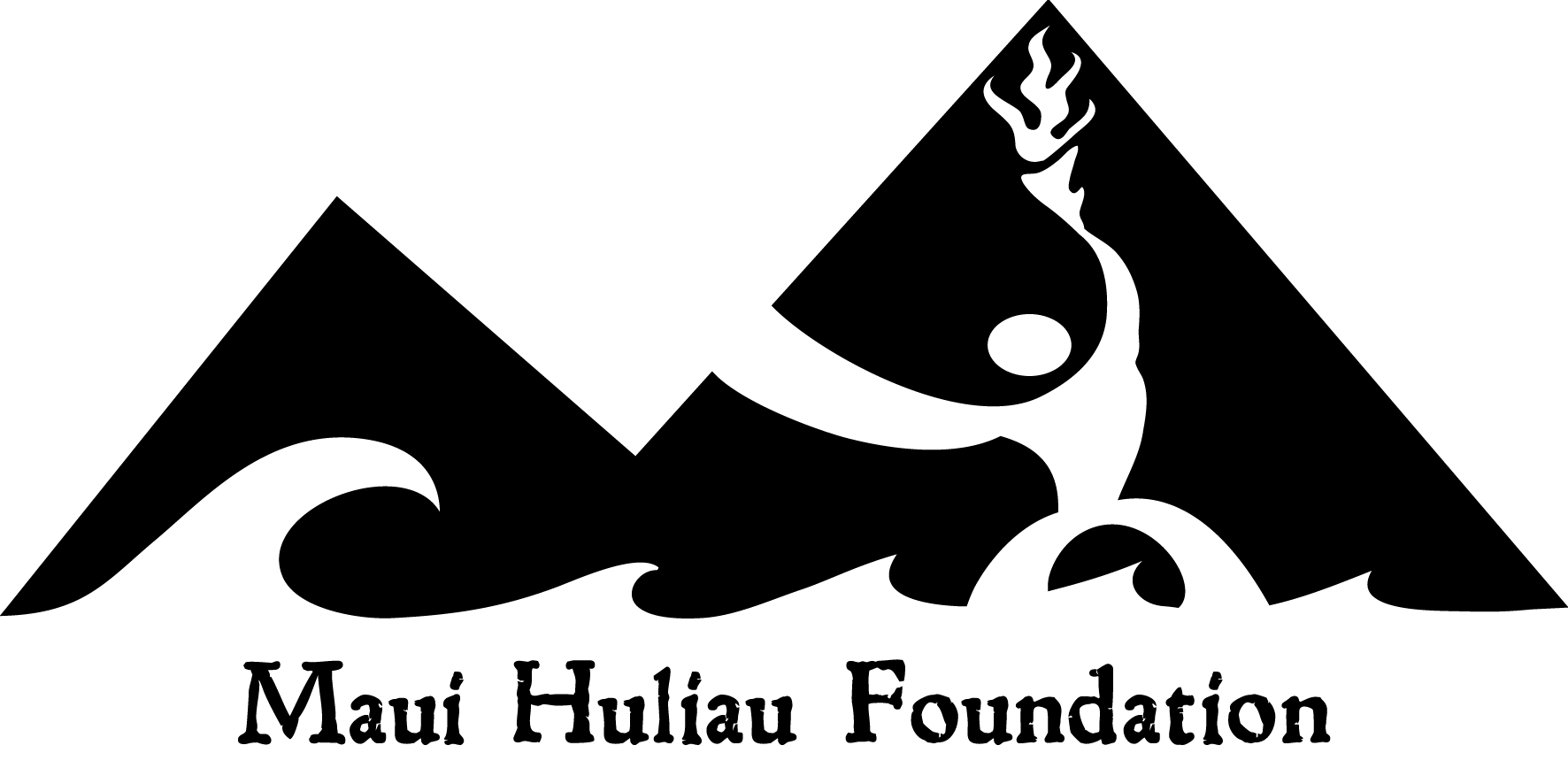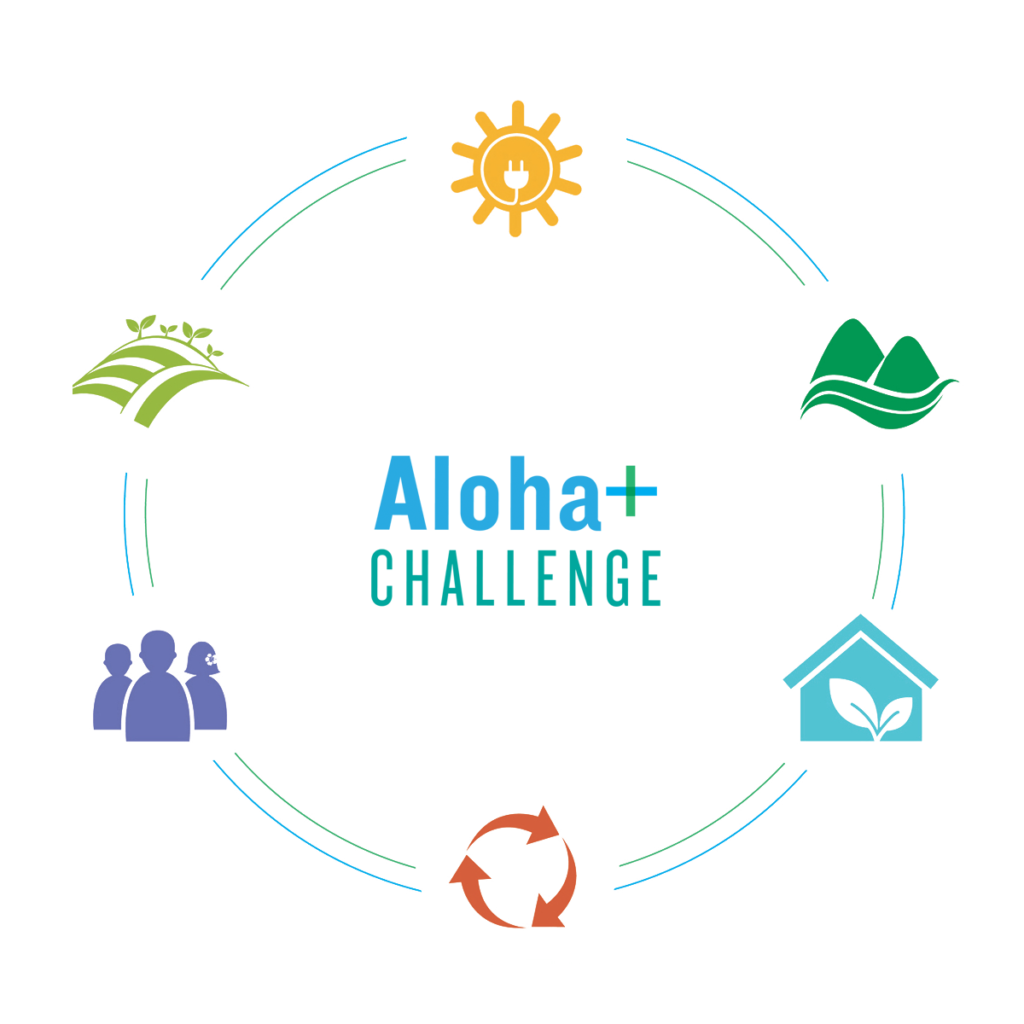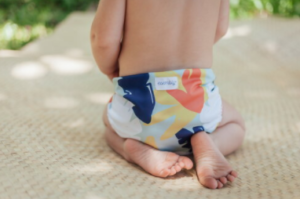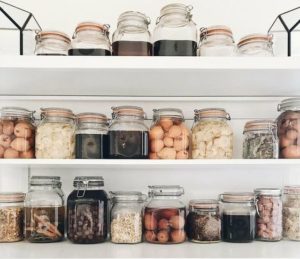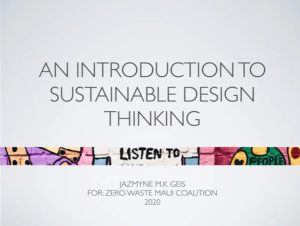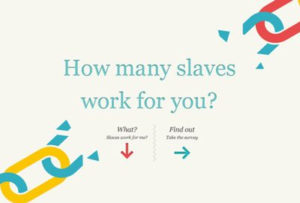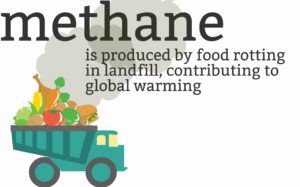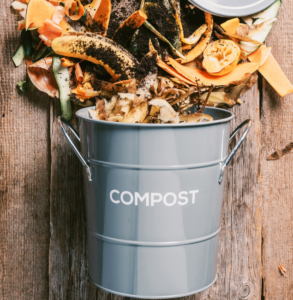SustʻĀINAbility Virtual Fair:
Going Zero Waste
April 22nd-29th, 2021
This virtual sustainability education event is co-hosted by Maui Huliau Foundation and Zero Waste Maui Coalition. Below you will find educational resources and pre-recorded workshops by both organizations on various aspects of sustainability and zero waste, as well as information on our live panel discussion on April 29th.
You can also stay in the loop by following us on social media using the links below.
EVENT Details
Zero Waste Educational Resources
Plastic Pollution
Consumption
Composting
Carbon Footprint
Sustainability Kahoot Competition
Complete our Kahoot by April 30th and win zero waste prizes!
Live Expert Panel
April 29th 5pm HST
The Future of Waste Reduction in Maui County
Other Sustainability Resources
Visit the Zero Waste Maui Coalition site for a list of zero waste vendors, sustainability consultants and more.
This event also has a Facebook event page here.
This virtual event is made possible, in part, by the County of Maui Department of Environmental Management.

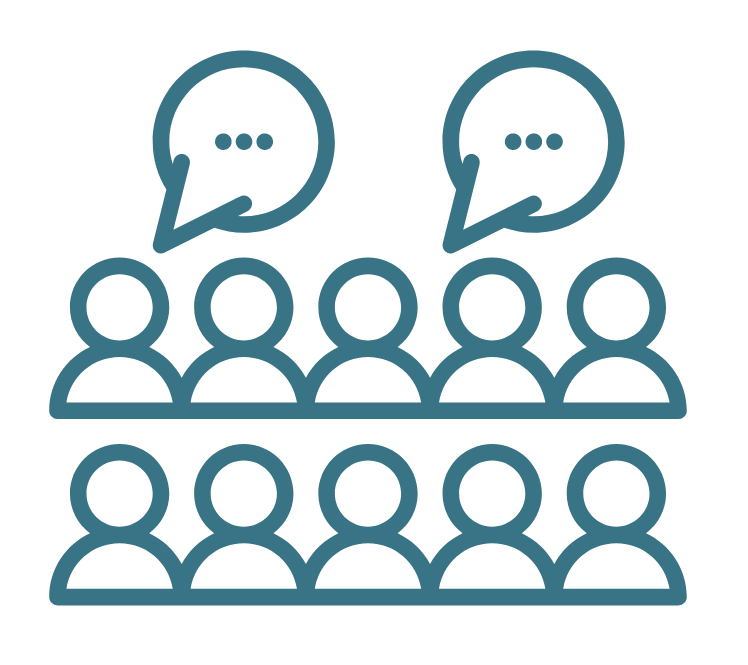
Live Expert Panel
April 29th 5-6:30pm HST
The Future of Waste Reduction in Maui County
A panel of local experts discusses the many challenges and opportunities surrounding waste reduction and disposal in Maui County including recycling, commercial composting, legislation, zero waste schools, and restaurants, and more. The panel will last one hour, followed by a half hour Q&A.
To participate visit our Facebook event page and you will be able to add questions in the comments during the live stream which will be answered during the Q&A, time permitting. If you do not have access to Facebook, please contact us and we can connect you via Zoom.
Meet Our Panelists

Kaimana Bingham
Aloha + Dashboard and Partnerships Manager, Hawai’i Green Growth
Before joining Hawai’i Green Growth, Kaimana worked for the State of Hawai’i Enterprise Technology Services branch where she implemented the first State Executive Branch IT Roadmap and Dashboard. Kaimana also participated as a stakeholder for the State of Hawai’i IT Strategic Plan. She recently served as panelist for the Hawai’i Virtual Digital Government Summit and as a sponsor for the ETS 2020 HACC program.

Hōkūao Pellegrino
‘Āina & Sustainability Learning Designer & Facilitator, Kamehameha Schools, Maui
As the ‘Āina & Sustainability Learning Designer & Facilitator, Hōkūao has worked to reduce waste, begin on-campus composting, grow school gardens, and implement other campus sustainability measures on the Kamehameha Schools Maui Campus. He also leads ‘āina-based community education programs at Noho’ana Farm, his ‘ohana’s taro farm in Waikapū, and is actively involved in multiple community groups working towards a more sustʻĀINAble future for Maui.
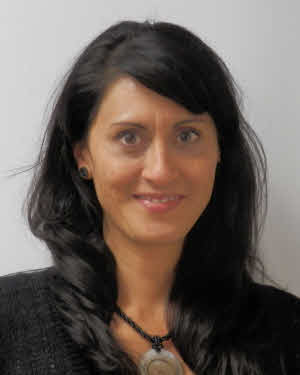
Tamara Farnsworth
Manager, County of Maui Environmental Protection & Sustainability Division

Gretchen Losano
Gretchen is a founding member of Zero Waste Maui Coalition. In 2016 she co-founded West Maui Green Cycle LLC, with the commitment to found a commercial co-composting operation in west Maui. In 2019 she worked with Grow Some Good to pilot a school food waste collection and composting program at Lahaina Intermediate. She has also served on many county and statewide task forces on plastic pollution, composting and agriculture.
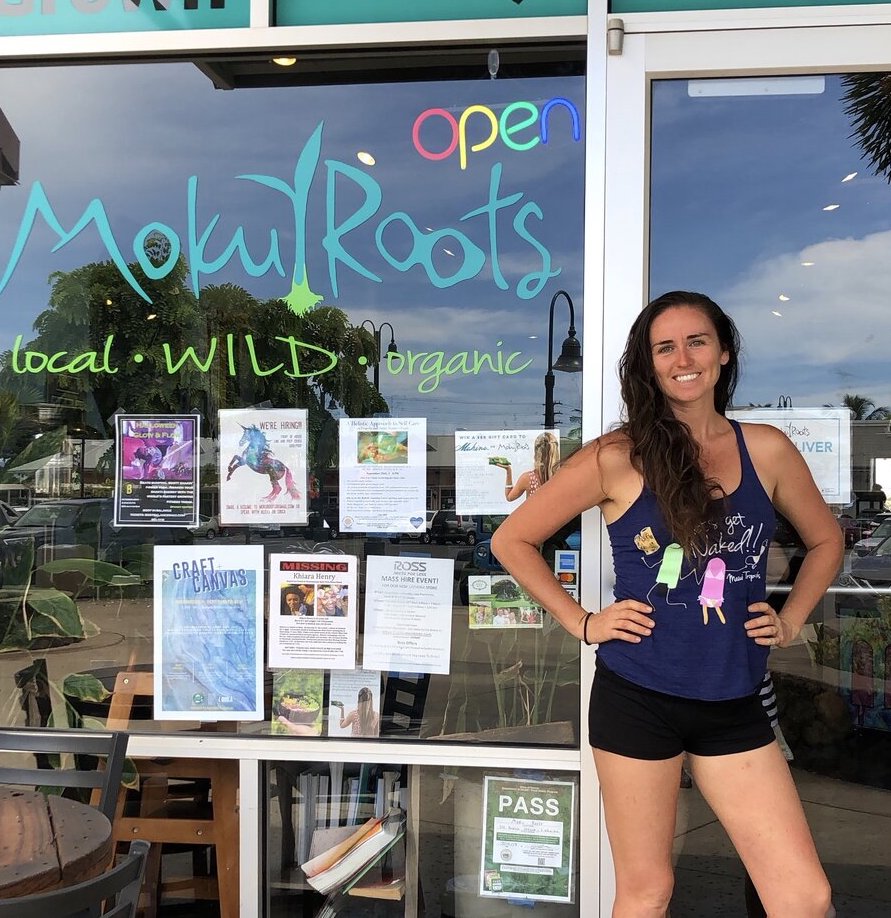
Alexa Caskey
Co-Owner, Moku Roots
Alexa is one of the co-owners of Moku Roots, Maui’s only zero waste restaurant. Alexa dreamt up the idea of Moku Roots after being disappointed about how wasteful takeout especially, but also dining in at a restaurant can be. We’re committed to supporting local agriculture and avoiding single use plastics.
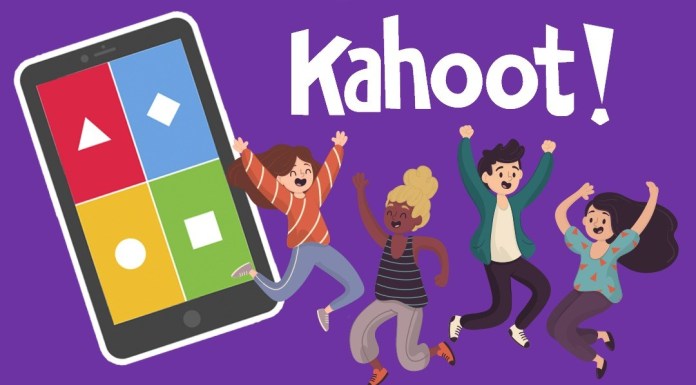
Note on rules: Kahoot is a game-based learning platform which scores you boht on your number of correct answers and how quickly you answer the questions. You must use your real full name in the game and can only play once. Follow our social media sites for the winner announcements and to claim your prize.
The Kahoot contains 30 questions covering content shared on this website. About a third of the questions come from the Sort Your Waste Quizlet (also featured in the Plastic Pollution section below) so be sure to complete that activity
Kahoot Competition
April 22nd-30th
After exploring the educational resources on this site, you can join our Kahoot competition to win cool prizes! Use the link below to join and complete the online quiz game by 8pm HST on April 30th. Zero waste prizes will be given to the top three winners, which will be announced on May 3rd on our Instagram and Facebook sites!
Zero Waste Educational Resources
Below you will find educational resources created by Maui Huliau Foundation students, staff and alumni, and by our partners at Zero Waste Maui Coalition. These resources include Prezi videos, pre-recorded workshops, infographics and Google-form based activities that you can do at home.
What is Zero Waste?
“The Zero Waste Hierarchy describes a progression of policies and strategies to support the Zero Waste system, from highest and best to lowest use of materials. It is designed to be applicable to all audiences, from policy-makers to industry and the individual.
Zero Waste: The conservation of all resources by means of responsible production, consumption, reuse, and recovery of products, packaging, and materials without burning and with no discharges to land, water, or air that threaten the environment or human health.”
– Zero Waste International Alliance
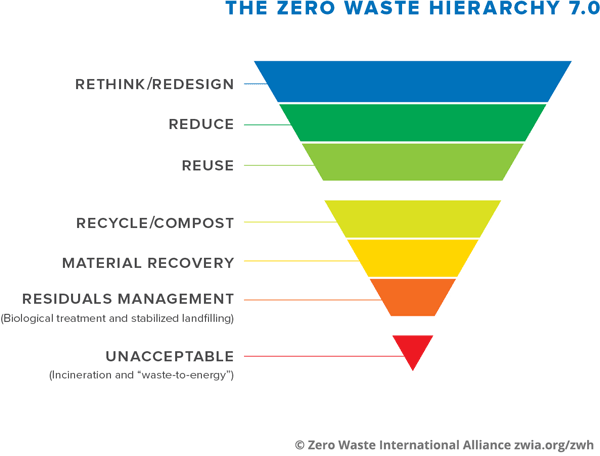
Aloha + Challenge
The Aloha+ Challenge is a statewide commitment to achieve Hawai‘i’s sustainability goals, and locally driven framework to implement the United Nations Sustainable Development Goals. Progress on the goals is measured on the Aloha+ Challenge Dashboard managed by Hawaiʻi Green Growth.
Plastic Pollution
Plastic pollution is the accumulation of plastic objects and particles in the Earth’s environment and can affect wildlife and their habitats, and humans. Plastics pose both a physical (entanglement, ingestion, and reef destruction) and chemical threat (bioaccumulation of the chemicals plastics are made of). Learn about ways you can reduce your use of single-use plastics.
Prezi Video by Huliau Leadership Council
Plastic Recycling & Wishcycling
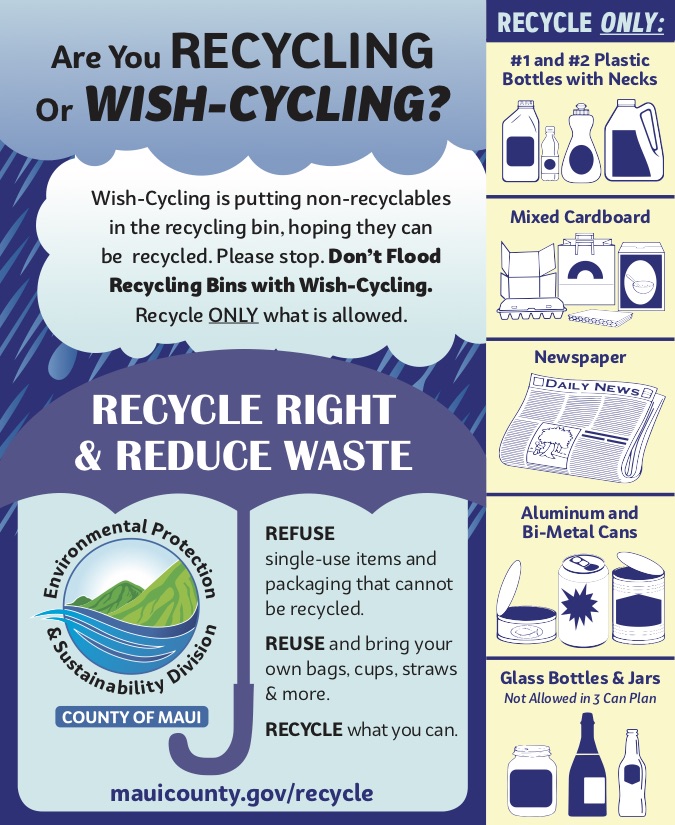 Maui residents and visitors can recycle cardboard, newspaper, glass containers, plastic bottles, and aluminum and steel cans at any of the County’s Recycling Drop Box Centers. Proper sorting is extremely important as all of us residents pay ($) for the extra management needed to clean up our recycling streams. Wishcycling contaminates raw materials going back on the market for reuse.
Maui residents and visitors can recycle cardboard, newspaper, glass containers, plastic bottles, and aluminum and steel cans at any of the County’s Recycling Drop Box Centers. Proper sorting is extremely important as all of us residents pay ($) for the extra management needed to clean up our recycling streams. Wishcycling contaminates raw materials going back on the market for reuse.
What is Wishcycling? It is the action of the well-intended consumer collecting and tossing non-recyclables in the recycling bin, hoping they can be recycled. In essence, wishcycling trashes the collection that a whole community has gathered through the actions of improper sorting and cleaning. In the end, all collective efforts to clean, sort, and gather materials to recycle are lost when the bin becomes contaminated. Please check out Zero Waste Maui Coalition’s recycling page to learn about proper sorting.
Bill 52: Preparing for Maui's Plastic Ban
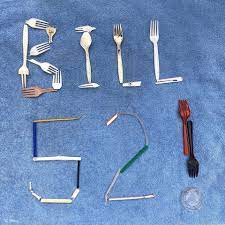
On April 21, 2020, Maui County adopted Bill 52, a comprehensive ban on single-use plastics. Bill 52 bans straws, cups, stirrers, to-go containers, and more and takes effect January 1, 2022.
Huliau Plastic Pollution Videos
Click here to explore the entire playlist.
Huliau Educational Activities
These educational activities from our virtual classrooms can help people of all ages learn ways to reduce their plastic waste, and learn which items can be diverted from the landfill through recyclying or composting.
Sort Your Waste Quizlet
Use this flashcard game to learn which types of waste can be recycled or composted, and which must be thrown in the landfill. Many of the questions in our Kahoot Competition are based on this activity*.
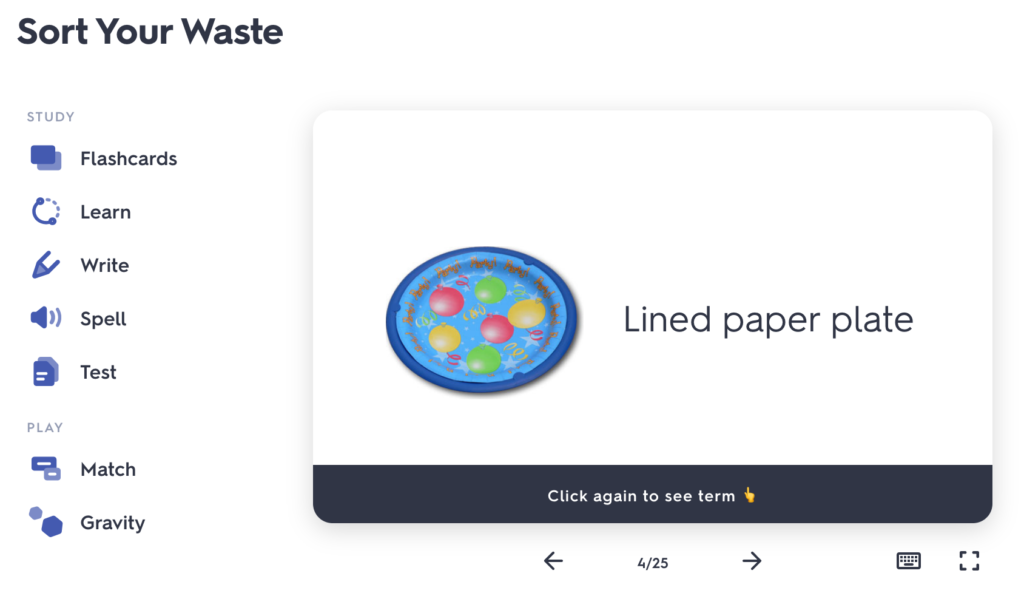
%
of plastic is recycled
At-Home Waste Audit
Use this guide to plan an at-home waste audit where you collect, sort and weigh your household waste for 3 days to help you identify ways to reduce waste at home.
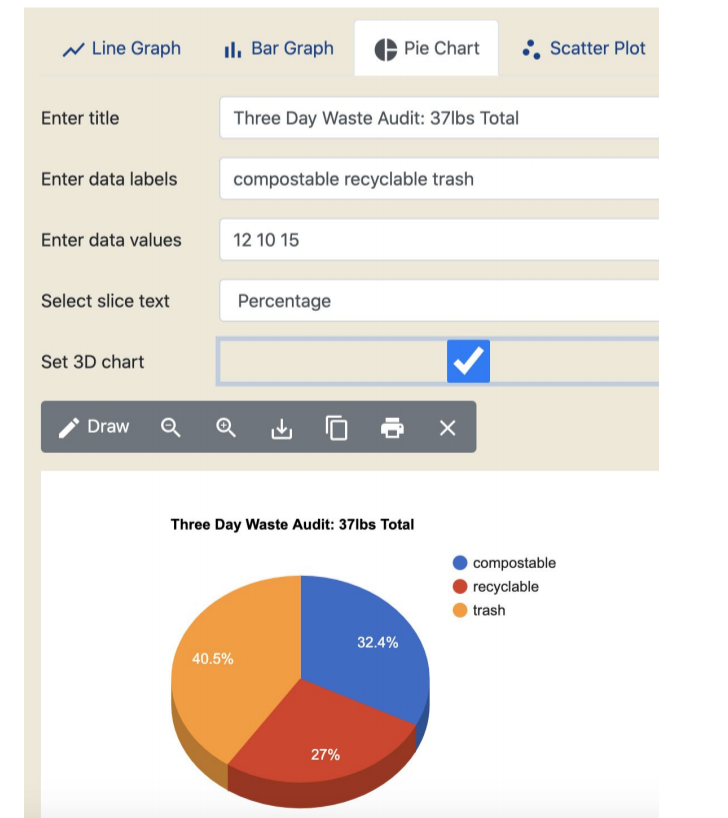
Sustainable Swaps & Zero Waste Hacks
Short videos created by Huliau Leadership Council sharing easy, sustainable swaps and hacks.
Consumption
Consumption is a natural process that allows organisms to turn waste into food, create new structures, and participate in nature’s endless flows and cycles. Consumption encompasses the environment, economy, culture, and people and is, therefore, a pivotal entry point to developing new cultural patterns and habits. It is also a vehicle for creativity, finding new opportunities and synergies to meet overlapping needs.
Prezi Video by Huliau Leadership Council
Four students from our Huliau Leadership Council share ways in which we can lead more sustainable lifestyles by becoming more conscious consumers.
Planned Obsolescence and Perceived Obsolescence
Planned obsolescence (obsolescence of function) is when products are intentionally designed for the dump, making them useless after a planned amount of time so that consumers need to buy a replacement over and over again, driving up sales. In the 1930’s, the idea of “creative waste” (throwing things away to then buy new ones) was seen as a patriotic act that would fuel a strong American economy. From that point on, industrial designers were asked by companies to be strategic in their design to make sure that the product would be functional enough for the consumer to have faith in the product, but not last long enough so that they would need a new one. Examples are plastic bags, take-out containers, mops, sponges, music players, computer desktops, mobile phones, kitchen appliances, washing machines, and so on.
Perceived obsolescence (obsolescence of desire) fills in the gap if planned obsolescence is not moving out product fast enough to push sales. Perceived obsolescence convinces consumers to throw away perfectly useful items just because it is no longer the trend of the status quo. Obvious examples of this are cars, home decor, fast fashion, and technology (such as phones, computers, and accessories). Why this is so successful is that it has infiltrated our culture and identities to a point where social pressures influence purchases to “stay relevant” and “be with the times”, not just corporations.
Circular & Linear Economy
As demand and consumption take a toll on Earth’s natural resources, the concept of shifting from a linear to a circular economy can help reduce overproduction, accumulation of waste, and depletion of natural resources. As more and more demand for resources goes up, the capacity of life-supporting resources goes down, leading to a treacherous gap that continues to tighten until nothing is left. This funnel image (inspired by the Natural Step) is led by behavior from the linear economy, which goes through a process of extracting materials, making products, and disposing of them. Whereas in a circular economy, materials and energy keep flowing within their systems in continuous loops, respectfully utilizing each extracted resource to the fullest. Instead of disposal, products are designed for infinite reuse. By design, a circular economy is restorative and regenerative rather than destructive and degenerating.
Greenwashing
“Greenwashing” refers to false or misleading marketing claims made by companies to suggest an environmental benefit of their product, service, or technology. Greenwashing makes it difficult for consumers to differentiate between a legitimate environmentally concerned product and one with just a marketing gimmick.
There is a guide to the Seven Sins of Greenwashing (created by TerraChoice Environmental Marketing) to help manufacturers, retailers and marketers better understand greenwashing and how to avoid consumer deception.
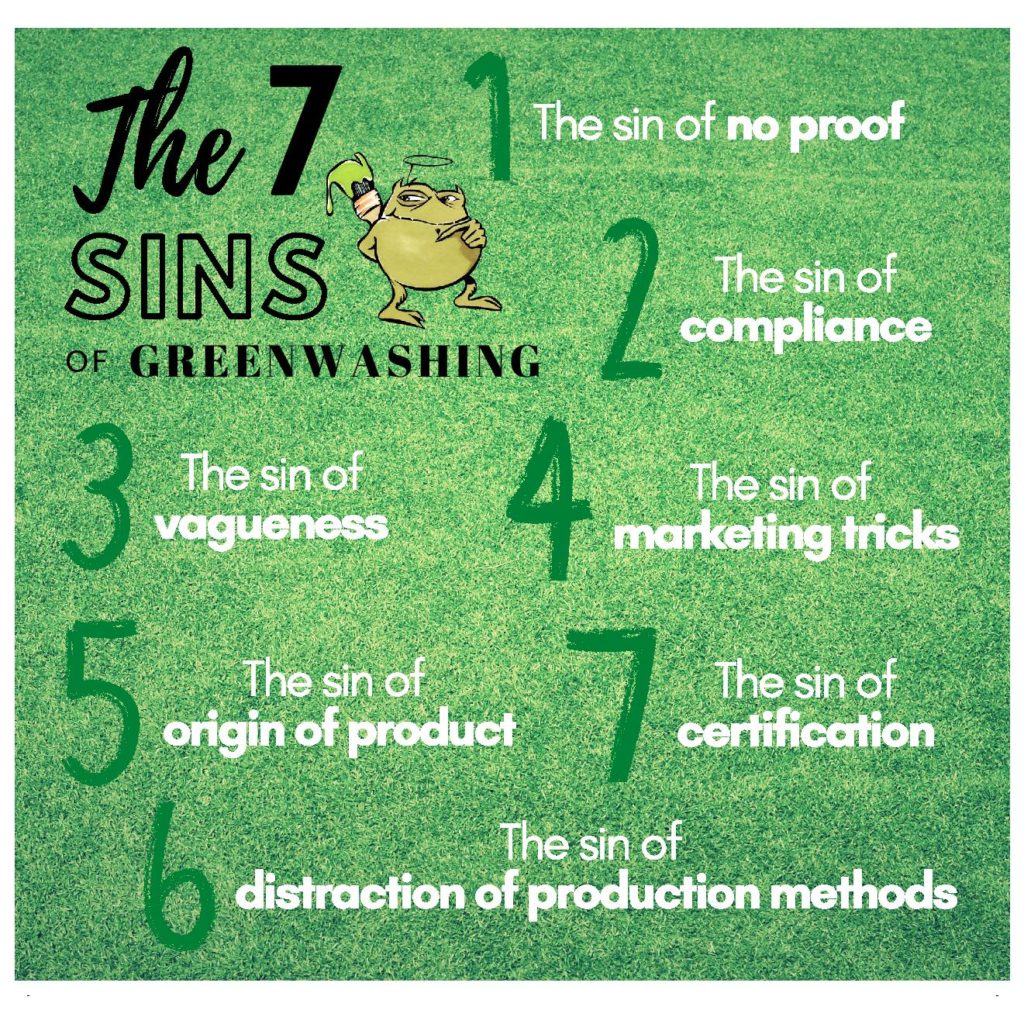
Designing Out Waste
We as people have the power to design ourselves out of the waste habits and products we create. All of our systems and human-built worlds, as well as the stuff within it, are a product of our creation. We’ve designed single-use products and the culture around disposables, and we can design our way out of it. All of us are creators contributing to the world around us, holding the power and responsibility to make the changes needed to shift us into an economy that is restorative and regenerative by design.
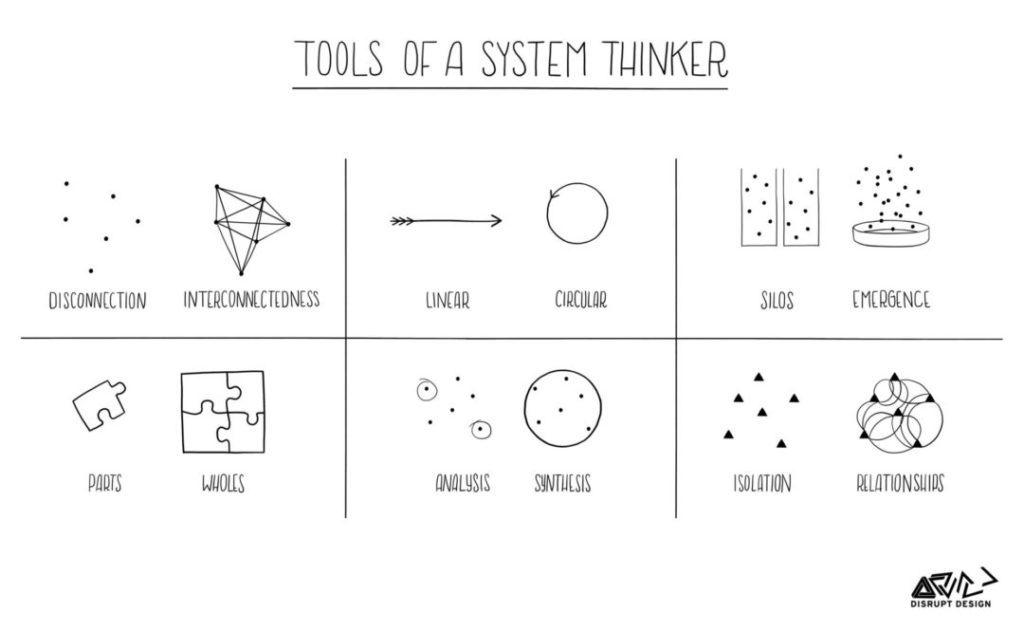
How is this done? To sustain a circular economy, products and services need to follow these three key principles:
- Design out waste and pollution from the start. (Using simple, safe, high-quality, recoverable materials is a great start.)
- Keep products in use and the integrity of the material resources high. Design for durability, reuse, remanufacturing, and recycling. (If you have a hybrid of multiple materials fused together, how easy will it be to assemble and disassemble for reuse? Think about the entire cycle of your creation from a mindset of relationships.)
- Design to regenerate natural systems. (How could we design to actively improve the environment?)
Huliau Educational Activities
Learn about sustainable fashion brands and alternatives to living a more sustainable lifestyle.
Sustainable Fashion
Conduct a closet audit to learn about your favorite brands and how sustainable they are using the Good On You directory.
Educational Workshops
Pre-recorded workshops by the Zero Waste Maui Coalition.
Composting
Composting is the natural process of organic materials turning into soil. The resulting soil is filled with beneficial microorganisms that help to improve plant growth. Compost also helps to hold moisture in the soil cutting down on the need to water in your garden. This organic fertilizer that can be made at home for free with some of the resources provided below. Reach out to Zero Waste Maui Coalition for further help, info@zerowastemauicoalition.com
Prezi Video by Huliau Leadership Council
Four students from our Huliau Leadership Council share more about the benefits of composting your food waste.
Organic Waste in Landfills
Organic waste in the landfill creates methane, a strong greenhouse gas that is contributing to climate change. By recovering this resource we not only can cut down on emissions but we can help create more resilient soils. Landfills are the third-largest source of human-related methane emissions in the United States, accounting for approximately 15.1 percent of these emissions in (EPA, 2018).
Types of Composting
There are countless different methods that can be used to compost, here are the basics that will help you get you started.
With Oxygen and Active Monitoring
Pros
- Can make finished compost as quick as 3 months
- Can take large volumes of yard and food waste at a time
- Can accommodate meat, dairy and oil if done correctly (with temperature monitoring of heat and moisture)
- Heat kills weed seeds and any potential pathogens
Cons
- Requires monitoring the heat and turning
- Requires a minimum of 3 x 3 x 3 feet for heat to be generated
- Can attract pests if meat and dairy is included and not well taken care of
- Pile works better if built all at once which requires collecting all of the needed materials beforehand
With Oxygen, No Active Monitoring
Pros
- Less work required in turning the compost
- Can build the pile over time as materials are available instead of all at once
- Can be smaller in size
Cons
- Without heat, the weed seeds may stay viable and end up in the finished product
- Takes much longer to get to a finished stage
- The pile may go anaerobic (void of oxygen) without turning which will stop the decomposition process and may start to smell
With Worms
Pros
- Great for small space composting, apartment or classroom composting
- Can have a harvestable compost (worm castings) in as little as 3 months
- Can eat almost all veggie and fruit scraps from the kitchen
- Size can be adapted to the number of food scraps produced
Cons
- Sensitive to extreme temperatures
- Need to monitor the moisture level
- Not meant for composting large amounts of yard waste
Educational Workshops
Check out these pre-recorded workshops by the Zero Waste Maui Coalition.
Huliau Educational Activities
In 2017 alone, almost 4.1 million tons of food waste was generated in the US, with only 6.3% diverted for composting.
Additional Video Resources
Carbon Footprint
Carbon dioxide is a greenhouse gas produced by numerous natural processes and by human activities such as the burning of fossil fuels. An increase in greenhouse gases like CO2 is the leading cause of climate change. Learn more about the impacts of climate change, calculate your carbon and ecological footprint, and explore solutions to climate change.
Prezi Video by Huliau Leadership Council
Four students from our Huliau Leadership Council share more about ways to reduce your carbon footprint.
Your Carbon Footprint
The term “carbon footprint” refers to the total greenhouse gas emissions caused directly or indirectly by an individual, organization, event, or product. Lifestyle factors like how much you travel, how much electricity you use, and what you eat all contribute to your carbon footprint. Small actions like eating less meat or taking one less trip each year can help lower your carbon footprint. Start by calculating your carbon footprint here to see what changes you can make!

The Greenhouse Effect
The greenhouse effect is a natural process that warms the Earth. When the Sun’s energy reaches the Earth’s atmosphere, some of it is reflected back to space and the rest is absorbed and re-radiated by greenhouse gases. The absorbed energy warms the atmosphere and the surface of the Earth. Although greenhouse gases play a crucial role in keeping our planet’s climate stable, too much CO2 and other greenhouse gases in the atmosphere enhance this effect, causing the average temperature of Earth to rise. This has multiple effects on Earths climate, which is what “climate change” refers to.
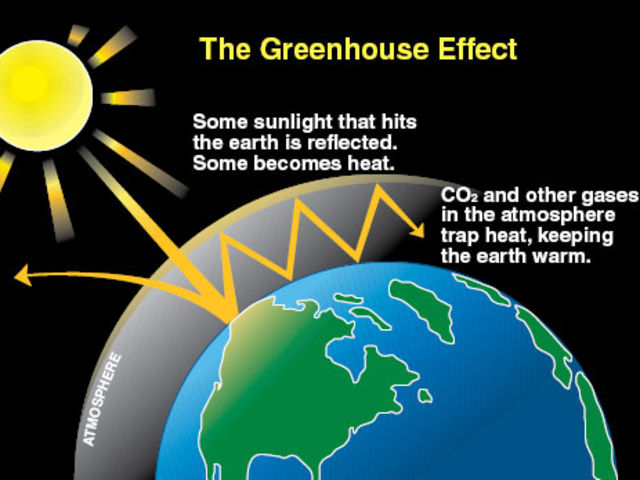
The carbon cycle is made up of natural carbon sinks and sources. A carbon sink sequesters or stores carbon, therefore, lowering the amount of CO2 in the atmosphere. Forests for example are an example of a carbon sink since they absorb CO2 through photosynthesis. Carbon sources, such as respiration by humans and animals, release CO2 into the atmosphere. However, the addition of man-made carbon sources, such as burning fossil fuels, and the destruction of sinks, such as forests, have increased the amount of CO2 in the atmosphere.
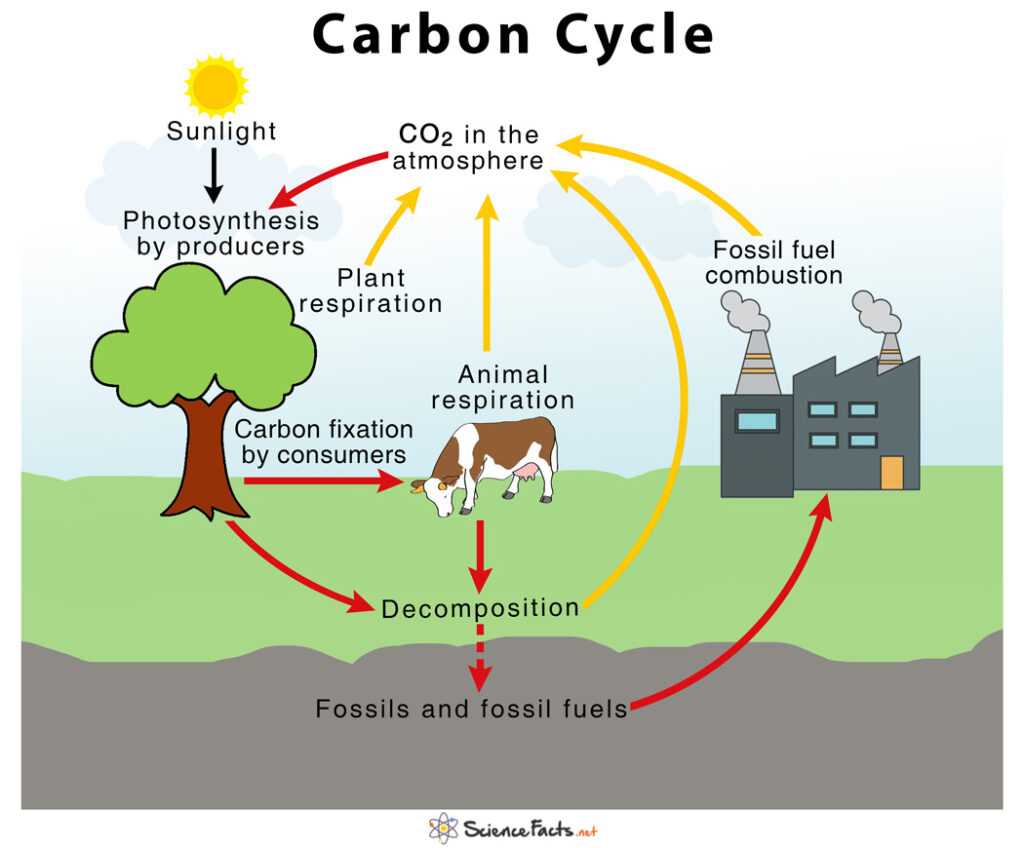
Impacts of Climate Change
Climate change impacts ecosystems and societies in a variety of ways. Things that we depend upon and value like water, energy, transportation, wildlife, agriculture, ecosystems, and human health are experiencing the effects of a changing climate. The image below shows some of the impacts Hawaiʻi is already experiencing as a result of climate change. For example, elevated ocean temperatures have resulted in severe coral bleaching, events that are becoming more frequent. Other impacts include sea-level rise, extreme heat, droughts, wildfires, and impacts on habitats and native species distribution.

Solutions: Mitigation and Adaptation
Responses to climate change generally fall into two categories: mitigation or adaptation. Mitigation involves reducing the amount of greenhouse gases entering the atmosphere or sequestering carbon dioxide by building or restoring carbon sinks. Adaptation is the process of adjusting to current or expected climate change and its effects. The image below shows different examples of mitigation and adaptation solutions. Some solutions are examples of both.
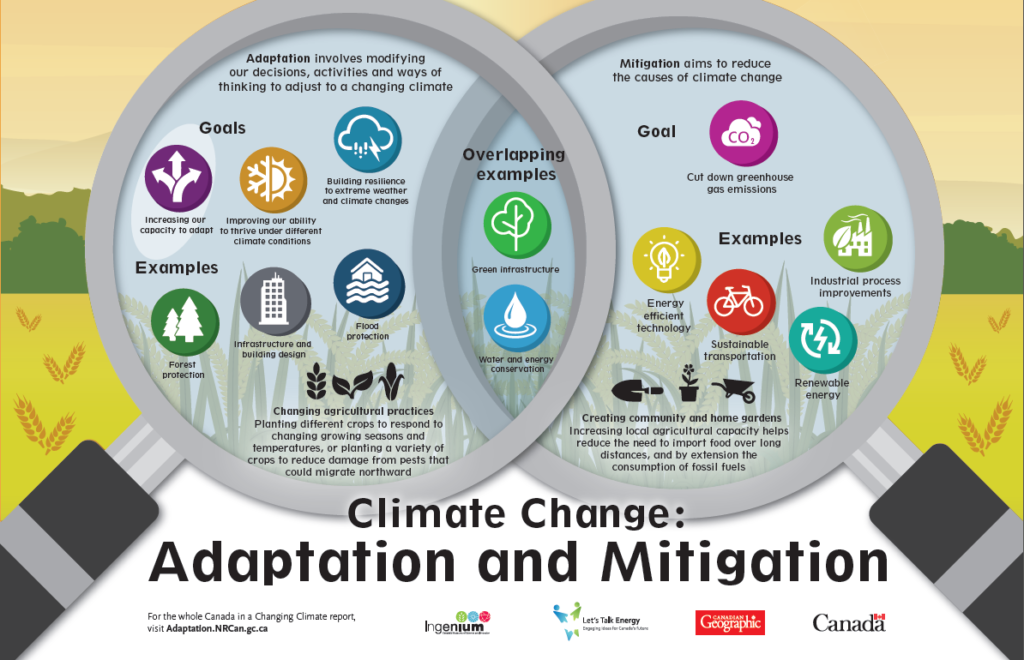
Climate resilience is the ability to anticipate, prepare for, and respond to hazardous events, trends, or disturbances related to climate. Improving climate resilience involves assessing how climate change will create new, or alter current, climate-related risks, and taking steps to better cope with these risks.
Huliau Educational Activities
Check out these educational activities to learn more about the impacts of and solutions to climate change.
Ecological Footprint Calculator
How many planets do we need if everyone lived like you? When is your personal overshoot day?
Sea Level Rise in Hawaiʻi
Explore the impacts of sea-level rise on Hawaiʻi’s coastlines.
Project Drawdown
Project Drawdown is a framework of solutions within different sectors on actions that can be taken today.
Huliau Climate Change Playlists
These Prezi video presentations from our Huliau Climate Literacy virtual classroom are organized it to chapters covering climate change causes, impacts and solutions. You can also learn more about our Huliau Climate Literacy Virtual Classroom for grades 8-12 covering climate change causes, impacts, and solutions here.
This Climate Change YouTube playlist contains videos produced by Huliau’s Environmental Filmmaking Club ranging from documentaries to music videos.
Zero Waste Maui Coalition
Zero Waste Maui is a community-based coalition of nonprofit organizations, businesses, and community members dedicated to rethinking our island’s relationship with “waste.”
